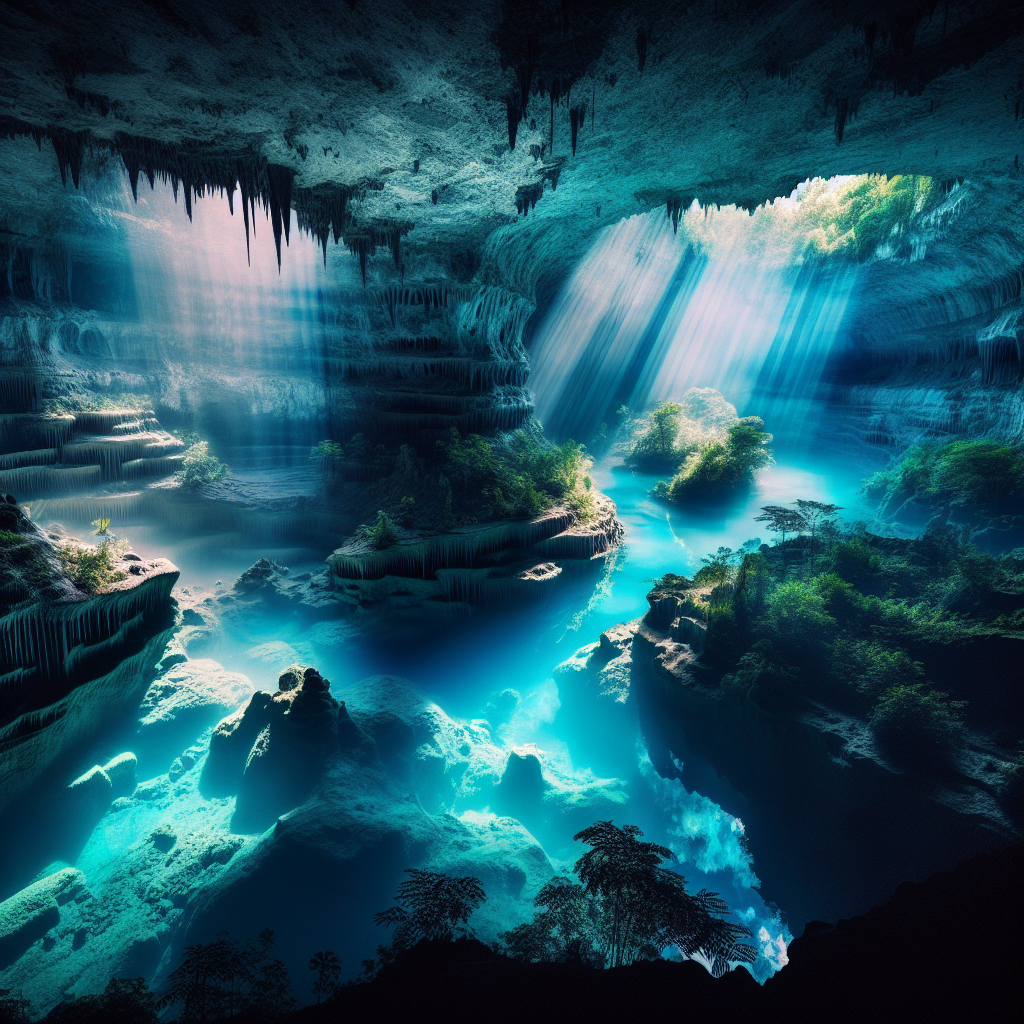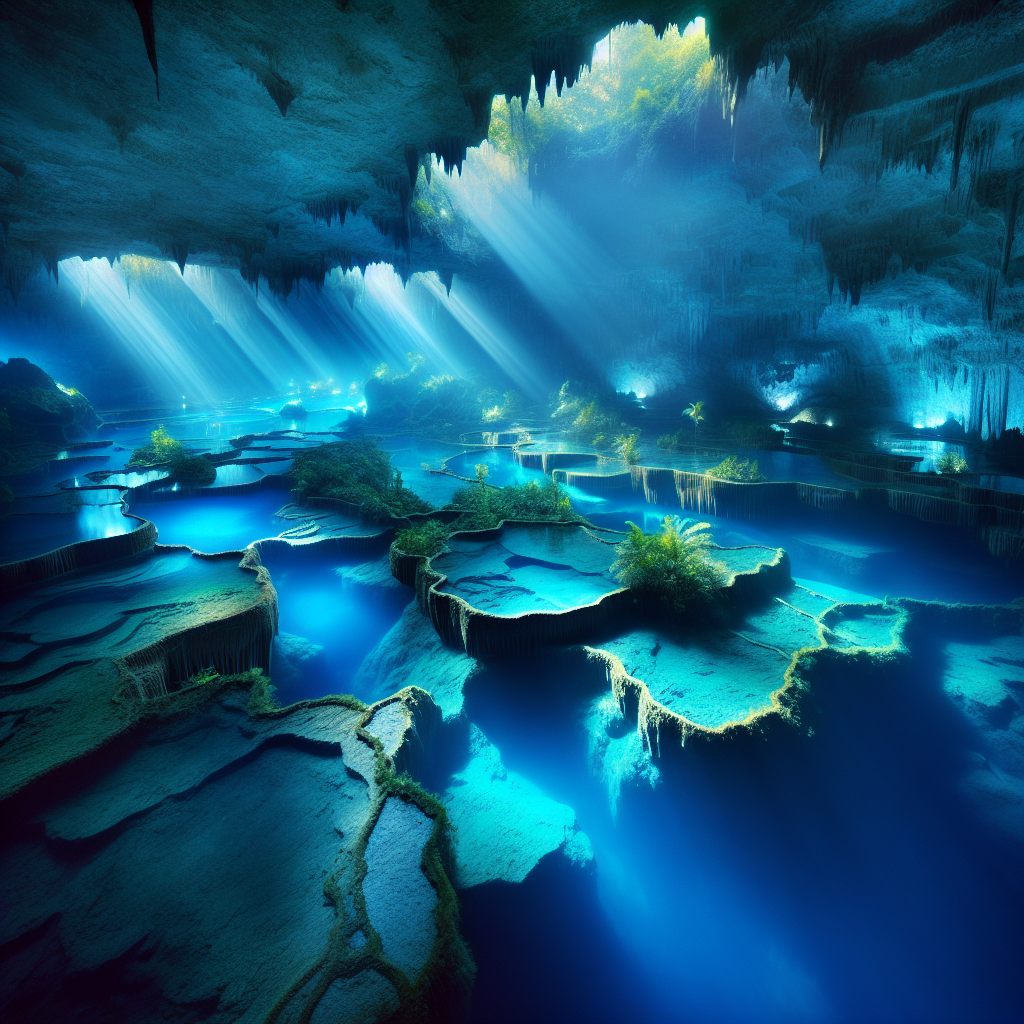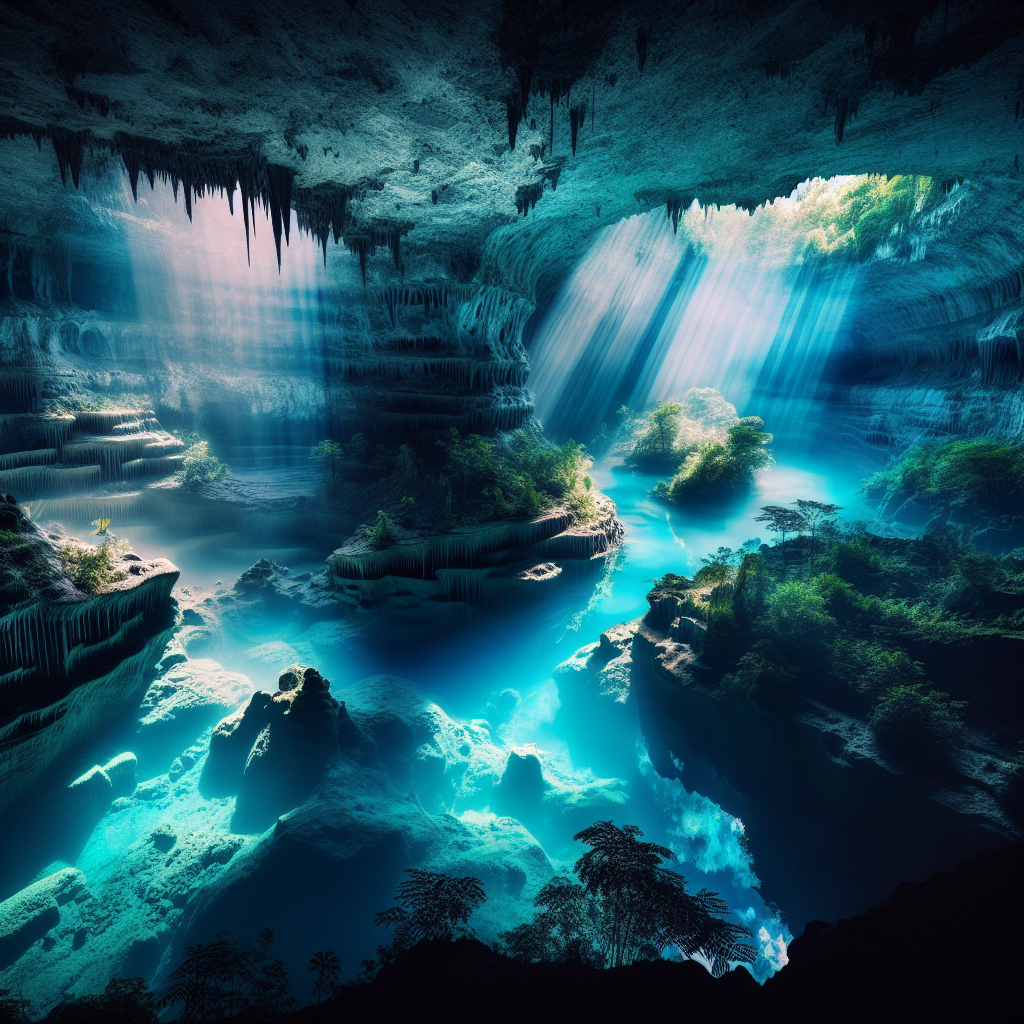Imagine embarking on a thrilling adventure, delving into the depths of Mexico’s underground rivers, where a world of secrets and mysteries awaits. As you navigate the winding passages, you’ll discover breathtaking natural wonders, from hidden caves adorned with stalactites to crystal-clear cenotes beckoning you to take a refreshing dip. Amidst the awe-inspiring sights, you’ll also uncover the secrets of these underground rivers, their formation, and the fascinating ecosystems that thrive within. Get ready to embark on a journey like no other as we unveil the secrets of Mexico’s underground rivers.

Introduction to Mexico’s Underground Rivers
Mexico’s underground rivers hold a certain allure and mystery that beckon adventurers from all around the world. With unique geological formations, enigmatic hidden pathways, and a wealth of natural wonders waiting to be discovered, these underground rivers offer a thrilling and unforgettable experience. Whether you’re a nature enthusiast, an avid explorer, or simply someone seeking an extraordinary adventure, Mexico’s underground rivers are sure to captivate your imagination.
Unique geological formations
One of the most fascinating aspects of Mexico’s underground rivers is the unique geological formations that have been shaped over thousands of years. These rivers flow through intricate cave systems, carved out by the slow but persistent forces of nature. Stalactites and stalagmites create surreal landscapes, while flowstones and dramatic draperies add an ethereal beauty to the underground chambers. The geological wonders found within these rivers are truly awe-inspiring.
Enigmatic hidden pathways
Navigating through Mexico’s underground rivers is an adventure in itself, as there are numerous hidden pathways and intricate mazes to explore. These hidden passages are formed by the erosion and dissolution of the limestone bedrock, creating a labyrinthine network of tunnels and chambers. Venturing into these unknown territories evokes a sense of excitement and anticipation, as you never know what wonders may lie just around the corner.
Natural wonders waiting to be discovered
Mexico’s underground rivers house an abundance of natural wonders that are waiting to be discovered by intrepid explorers. From breathtaking crystal caves like the Cueva de los Cristales in Naica to the world’s longest underwater cave system known as Sistema Sac Actun, the underground rivers offer a multitude of awe-inspiring sights. From stunning rock formations to the mesmerizing reflections of light on crystal-clear waters, each corner of these hidden rivers reveals a new marvel of nature.
Formation and Characteristics of Underground Rivers
To truly appreciate the beauty and significance of Mexico’s underground rivers, it is important to understand the geological processes that have shaped them and the unique characteristics that define them.
Geological processes shaping the underground rivers
Mexico’s underground rivers owe their existence to a combination of geological processes that have played out over millions of years. The region’s karst topography, characterized by soluble limestone bedrock, allows for the creation of underground rivers through a process known as karstification. Rainwater seeping through the cracks in the limestone gradually dissolves the rock, creating underground channels and cave systems. Over time, these channels widen and deepen, forming the magnificent underground rivers we see today.
Cenotes and sinkholes as access points
Cenotes, natural sinkholes formed by the collapse of limestone, serve as access points to Mexico’s underground rivers. These cenotes are often filled with crystal-clear groundwater, providing a glimpse into the hidden world beneath the surface. Swimming in a cenote and exploring its depths can lead to the discovery of an underground river, opening up a whole new realm of exploration.
Hydrological features of the underground river systems
Mexico’s underground river systems are characterized by their continuous flow of water, despite being hidden beneath the earth’s surface. This water originates from rainwater infiltrating the ground and seeping into the underground channels. The flow of these rivers is influenced by the topography of the land above, with the water often cascading through waterfalls, creating mesmerizing natural spectacles. The hydrological features of these underground rivers contribute to the unique and captivating experience of exploring them.
Famous Underground Rivers in Mexico
Mexico is home to several famous underground rivers that have attracted adventurers and nature enthusiasts from all corners of the globe. Let’s dive into some of the most renowned underground rivers in the country.
Rio Secreto in the Yucatan Peninsula
Located in the Yucatan Peninsula, Rio Secreto is a natural wonder that offers an unforgettable underground experience. This subterranean river winds its way through a maze of caves adorned with stunning stalactites and stalagmites, transporting visitors into an otherworldly realm. Exploring Rio Secreto provides a unique opportunity to witness the beauty of Mexico’s underground rivers up close and personal.
Sistema Sac Actun, the world’s longest underwater cave system
Sistema Sac Actun, also known as the White Cave System, holds the distinction of being the longest underwater cave system in the world. Stretching over 215 miles (347 kilometers), this cave system is a paradise for cave divers and explorers. Its vast network of submerged passageways and breathtakingly beautiful chambers showcases the true magnificence of Mexico’s underground rivers.
Cueva de los Cristales, the crystal cave in Naica
Hidden deep within the Naica mine in Chihuahua, Mexico, lies the incredible Cueva de los Cristales, or the Crystal Cave. This underground marvel is home to some of the largest known natural crystals on Earth. The crystals, composed mainly of gypsum, can reach staggering sizes of up to 39 feet (12 meters) long. Venturing into this surreal cave provides a glimpse into the mesmerizing beauty that nature can create.
The mysterious Actun Tunichil Muknal cave
Actun Tunichil Muknal, commonly referred to as ATM, is not only an underground river but also an archaeological site of great significance. Located in Belize, just across the border from Mexico, this limestone cave holds a wealth of ancient Mayan artifacts and even sacrificial remains. Exploring ATM is a thrilling and educational experience that allows you to step back in time and uncover the mysteries of the ancient Mayan civilization.
Flora and Fauna of Mexico’s Underground Rivers
Mexico’s underground rivers are not only rich in geological wonders, but they also support unique ecosystems that have adapted to thrive in darkness. Let’s take a closer look at the flora and fauna that call these underground rivers home.
Unique ecosystems thriving in darkness
The absence of sunlight in underground rivers has given rise to specialized ecosystems that have adapted to survive in these challenging conditions. These ecosystems are highly sensitive to changes in the natural environment and have a delicate balance of interdependent species. By studying and understanding these underground ecosystems, scientists gain valuable insights into the potential impacts of human activities on natural environments.
Eyeless cave-dwelling fish and other curious creatures
One of the most remarkable inhabitants of Mexico’s underground rivers are the eyeless cave-dwelling fish known as “sightless cavefish” or “blinds.” These fish have evolved to thrive in the complete darkness of the underground rivers, relying on other senses to navigate and find food. Beyond the sightless cavefish, these rivers are also home to other curious creatures such as blind shrimp, cave-dwelling spiders, and unique aquatic invertebrates.
Rare plant species adapted to the underground environment
In addition to the fascinating fauna, Mexico’s underground rivers also support a variety of rare plant species that have adapted to the dark and nutrient-poor conditions. Some plants in these underground ecosystems grow in unusual ways, relying on alternative sources of nutrients and light, such as the glow of bioluminescent organisms. Discovering these hidden plant species adds to the wonder of exploring the underground rivers and showcases the resilience of nature.

Importance of Underground Rivers for the Local Communities
Mexico’s underground rivers hold immense importance for the local communities residing in close proximity to these natural wonders. Let’s delve into the various ways in which these rivers impact the lives of the people and the environment.
Ancient Mayan rituals and spiritual significance
For the indigenous communities of Mexico, particularly the Maya, underground rivers hold deep spiritual significance. These rivers were considered sacred by the ancient Mayans and were often used as sites for rituals and ceremonies. The reverence for these underground rivers has been passed down through generations, and traditional spiritual practices and beliefs continue to thrive around these natural wonders.
Providing a sustainable freshwater source
Mexico’s underground rivers play a vital role in providing a sustainable source of freshwater for both the local communities and the surrounding ecosystems. These hidden rivers act as natural filters, purifying the groundwater and supplying clean water to nearby communities. The presence of these underground rivers ensures a constant supply of freshwater even during dry seasons when surface water sources may become scarce.
Tourism and economic benefits
The underground rivers in Mexico have become major tourist attractions, drawing visitors from around the world. The tourism industry surrounding these natural wonders has provided significant economic opportunities for local communities. Through ecotourism initiatives, communities have been able to preserve and protect these underground river systems while also benefiting from the economic influx generated by tourism activities, such as guided tours and accommodation options.
Exploring Techniques and Safety Precautions
Exploring Mexico’s underground rivers requires careful planning and adherence to safety protocols. Here are some essential techniques and precautions to ensure a safe and enjoyable adventure.
Cave diving essentials
Cave diving, an integral part of exploring underground rivers, requires specialized training and equipment. Proper cave diving certification is essential to understanding the unique challenges and hazards associated with underwater cave systems. This certification provides divers with the necessary skills and knowledge to navigate safely in the dark and confined spaces of underground rivers.
Equipment and gear recommendations
To ensure a safe and comfortable exploration of Mexico’s underground rivers, it is crucial to have the appropriate equipment and gear. A quality dive mask, fins, and a reliable underwater flashlight are essential items for navigating through the dark passageways. Additionally, a wetsuit or drysuit is recommended to maintain body temperature in the chilly underground waters.
Professional guides and recommended routes
Engaging the services of professional guides is highly recommended when exploring Mexico’s underground rivers. These experienced guides possess in-depth knowledge of the river systems and can provide valuable insights into the geological, historical, and ecological aspects of the caves. Following recommended routes ensures a structured and safe exploration, minimizing the risk of getting lost or encountering potential hazards.
Captivating Formations and Geological Wonders
Entering Mexico’s underground rivers is like stepping into a hidden world filled with captivating formations and geological wonders. Let’s take a closer look at some of the incredible features that make these underground rivers truly mesmerizing.
Stalactites and stalagmites: Nature’s sculptures
Stalactites and stalagmites are some of the most iconic formations found within Mexico’s underground rivers. These natural sculptures are created as mineral-rich water drips from the ceiling and floor, leaving behind deposits of calcium carbonate. Over time, these deposits build up, forming elongated icicle-like stalactites from the ceiling and upward-reaching stalagmites from the floor. The interplay of light and shadows on these formations creates a breathtaking visual spectacle.
Flowstones and dramatic draperies
Flowstones, also known as cave bacon, are another stunning feature commonly found in Mexico’s underground rivers. Formed by the slow dripping of mineral-rich water along cave walls, flowstones create smooth, flowing patterns that resemble melting wax or layered curtains. When illuminated, these flowstones showcase a spectrum of colors and textures, adding to the surreal beauty of the underground chambers.
The mesmerizing effect of underwater light reflections
One of the most enchanting aspects of exploring Mexico’s underground rivers is the interplay of light with the crystal-clear waters. As sunlight pierces through the surface and reflects off the water, it creates an ethereal glow that bathes the underground chambers in an otherworldly radiance. This phenomenon highlights the delicate formations and enhances the overall enchantment of the underground river experience.
Preservation Efforts and Environmental Concerns
As more and more visitors flock to Mexico’s underground rivers, there is a growing need to balance the preservation of these delicate ecosystems with the demands of tourism. Let’s explore the preservation efforts and environmental concerns associated with these natural wonders.
Protecting delicate underground ecosystems
Preserving the delicate underground ecosystems is of utmost importance to ensure the long-term survival of Mexico’s underground rivers. Efforts are being made to establish protected areas around these rivers, limiting access and implementing regulations to minimize human impacts. By restricting visitor numbers and setting strict guidelines for exploration, authorities aim to protect the unique flora and fauna that call these rivers home.
Balancing tourism with conservation
The surge in tourism surrounding Mexico’s underground rivers presents a challenge in striking a balance between economic development and conservation. Sustainable tourism practices, such as responsible waste management and minimal environmental disturbance, are being implemented to mitigate the potential negative impacts on these fragile ecosystems. By educating visitors on the importance of responsible tourism, local communities and authorities can preserve these natural wonders for future generations.
Scientific research and monitoring initiatives
Scientific research and monitoring initiatives are crucial for better understanding the underground river systems and the impact of human activities on these fragile environments. Collaborative efforts between researchers, local communities, and authorities are underway to collect data on water quality, flora, fauna, and geological formations. This research provides essential insights that inform conservation strategies, management plans, and the development of sustainable tourism practices.
Mythology and Folklore Surrounding Underground Rivers
Mexico’s underground rivers have been steeped in mythology and folklore for centuries. Let’s explore some of the captivating tales and cultural significance associated with these subterranean wonders.
Tales of ancient Mayan deities
In Mayan mythology, underground rivers were believed to be the domain of Chaac, the god of rain, who controlled the life-giving waters. According to ancient tales, it was through these rivers that Chaac replenished the land with rain, ensuring the fertility of crops and the well-being of the people. The mythology surrounding underground rivers highlights their importance as a source of life and sustenance.
Legends of hidden treasures and guardian spirits
Legends of hidden treasures and guardian spirits have long entranced the imaginations of those who explore Mexico’s underground rivers. These tales speak of hidden riches, magical artifacts, and mysterious beings that protect the underground realms. While these legends may remain rooted in folklore, they add an air of mystique and adventure to the exploration of these hidden wonders.
Cultural significance and storytelling traditions
The mythology and folklore surrounding Mexico’s underground rivers are deeply ingrained in the cultural fabric of the country. Traditional storytelling and oral traditions have helped to pass down these tales from generation to generation, ensuring that the rich cultural history of these subterranean wonders is preserved. Exploring Mexico’s underground rivers is not just a physical adventure but also an opportunity to immerse oneself in the cultural heritage that has shaped the land.
Beyond Underground Rivers: Discovering Mexico’s Subterranean Wonders
Mexico’s underground rivers are just the beginning of a world waiting to be discovered beneath the surface. Let’s venture beyond the rivers and explore other subterranean wonders that Mexico has to offer.
Exploring cenotes and underground cave systems
Aside from the underground rivers, Mexico boasts an extensive network of underground cave systems and cenotes. Cenotes are natural sinkholes that provide access to submerged cave systems, inviting exploration and discovery. These subterranean wonders offer a diverse range of experiences, including swimming in pristine cenote waters, spelunking through hidden caves, and marveling at spectacular underground formations.
Underground rivers as part of broader cave networks
Mexico’s underground rivers are often interconnected with broader cave networks, giving adventurers the opportunity to explore and discover new hidden treasures. Diving deeper into these extensive cave systems allows for a more comprehensive understanding of the geological forces that have shaped the subterranean landscape over millennia. Uncovering passageways, chambers, and further underground rivers is an adventure that reveals the true extent of Mexico’s subterranean wonders.
Adventures beyond the rivers: lava tubes and subterranean lakes
Beyond the underground rivers and cave systems, Mexico is also home to other subterranean wonders such as lava tubes and subterranean lakes. Lava tubes are created by the flow of lava during volcanic eruptions, leaving behind long, tunnel-like structures. Exploring these lava tubes takes you on a journey through ancient volcanic history. Subterranean lakes, on the other hand, offer a surreal underwater experience, where divers can navigate through submerged chambers and marvel at the unique beauty of these hidden aquatic worlds.
In conclusion, Mexico’s underground rivers present a world of awe-inspiring beauty, geological wonders, and cultural significance. From their unique geological formations and characteristics to the delicate ecosystems and captivating folklore, these subterranean wonders have much to offer. By exploring and appreciating Mexico’s underground rivers, we not only connect with nature at its most fascinating but also play a part in protecting and preserving these remarkable natural treasures for generations to come. So, dive into the depths, unveil the secrets, and embark on the thrilling adventure of exploring Mexico’s underground rivers.
